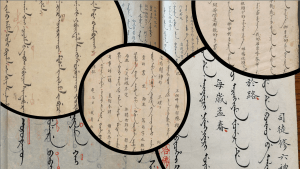We cordially invite you to join us on Friday, October 25, at 4:45-6:45pm CT, CWAC 152 for our first VMPEA workshop this fall. This workshop features:
Peter Yuheng Deng
MAPH 2nd Year, UChicago
Who will be presenting the paper titled:
“The Borderless Circle: Yoshihara Jirō’s Enso”
This workshop will take place in hybrid format. For those who would like to join online, please register here.
Please see the abstract and bio for this workshop below.
We hope to see many of you there!

Image: Jiro Yoshihara (1950-1972), White Circle on Black. 1965. Acrylics on canvas. 182.0 × 227.5cm. National Museum of Modern Art, Tokyo.
Abstract:
This paper examines a lesser-explored aspect of Yoshihara Jirō’s work, focusing on his Enso paintings, and situates these works within the context of the internationalization of “dentō” or tradition in the Japanese postwar avant-garde movement. The Enso paintings, created in oil and acrylic, represent Yoshihara’s response to combat the systematic marginalization of non-Western art in a predominantly Euro-American art world. By leveraging the Zen symbol of Enso, Yoshihara aimed to establish a more equitable form of artistic exchange that transcends cultural boundaries, promoting a “borderless” dialogue.
The Enso, a symbol of enlightenment in Zen Buddhism, signifies the non-dualistic nature of reality, challenging distinctions between representation and abstraction, as well as between writing and picturing. Yoshihara’s choice of this symbol was not a superficial nod to Japanese tradition but a deeply considered effort to integrate Japan’s cultural heritage into the global abstract expressionist movement. His work sought to counteract the perception of Japanese art as marginal and derivative, highlighting its intrinsic value within the global art narrative.
This paper explores how Yoshihara’s abstract renderings of Enso, through their imperfect and eccentric forms, embody the principles of Zen and engage with the aesthetics of abstract expressionism. It examines the significance of the Enso in Zen practice, where it serves as both an artistic and spiritual exercise, and how Yoshihara recontextualized this tradition within his modernist framework.
Yoshihara’s Enso paintings are analyzed in the context of their historical reception, particularly the challenges faced during the First Japanese Art Festival in Chicago in 1966 and the earlier skepticism from Western critics. By drawing parallels between traditional Zen calligraphy and modern abstract art, the paper argues that Yoshihara’s work represents a crucial intersection between Eastern and Western art forms, contributing to a more inclusive and multifaceted understanding of postwar global art as transnational history.
Yoshihara Jirō’s Enso paintings reflect a synthesis of East Asian and Western artistic traditions, advancing a vision of art that transcends cultural and geographical boundaries. His work exemplifies a deliberate effort to reframe Japanese art within a global context, overcoming representation and eliding the differences between writing and picturing, ethnicity and universality.
Bio:
Peter Yuheng Deng is a master’s student in Art History at the University of Chicago, specializing in Japanese 19th-20th century Japanese art. He holds a bachelor’s degree in East Asian Studies from Haverford College. His current research explores the role of tradition in early post-war Japanese contemporary art and how material culture challenges the dichotomies between East and West, local and universal.
Beyond his academic pursuits, Yuheng is also a passionate performance artist and painter. His creative practice seeks to blend diverse artistic forms, particularly through theater and performance painting. By merging his artistic practice with his theoretical research, Yuheng aims to address canonical issues in contemporary East Asian art and foster new dialogues between traditional and modern expressions.






 Image: Shimada Yoshiko, Becoming a Statue of a Japanese ‘Comfort Woman’ & The Tomorrow Girls Troop, Against Forgetting. Photograph by Qianwen Jiang.
Image: Shimada Yoshiko, Becoming a Statue of a Japanese ‘Comfort Woman’ & The Tomorrow Girls Troop, Against Forgetting. Photograph by Qianwen Jiang.